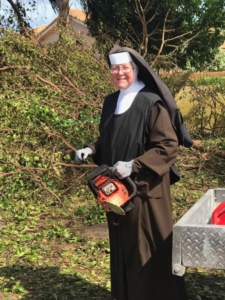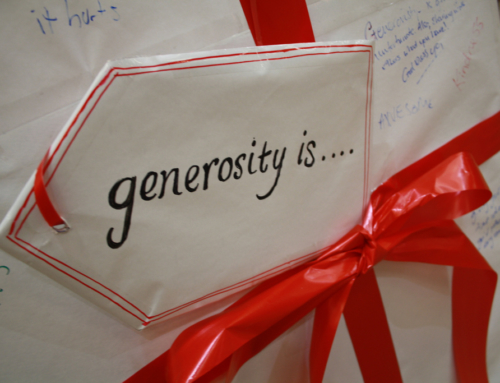By Eddie Pipkin
September 18, 2017
So, here I am again, writing about churches and disaster response, only this time from a city in which, a  week after Irma blew through, there are still some households without power, and the streets of my own neighborhood are lined with large debris piles. Call it the unexpected “The Church and Disaster Response Part 2” blog. I wrote about Harvey and its effects from several states away, but Irma I got to see up close and personal. I was reminded of the unique slow-motion drama that is a hurricane’s unique impact on a community: 1) The anxiety and preparation of tracking the storm’s progress and arrival; 2) The direct experience of the storm itself; and 3) The recovery and struggle to return to normalcy.
week after Irma blew through, there are still some households without power, and the streets of my own neighborhood are lined with large debris piles. Call it the unexpected “The Church and Disaster Response Part 2” blog. I wrote about Harvey and its effects from several states away, but Irma I got to see up close and personal. I was reminded of the unique slow-motion drama that is a hurricane’s unique impact on a community: 1) The anxiety and preparation of tracking the storm’s progress and arrival; 2) The direct experience of the storm itself; and 3) The recovery and struggle to return to normalcy.
The local church can have a valuable role in each of these three phases. The level of response is tied to the resources and infrastructure available to a given congregation, but every church, regardless of size or financial resources, can do its part. Much of this is determined by the already established patterns of community connection (see last week’s blog entry), but our guiding principle should be to just jump in, take action and do something: “Do what you can to help.” That is a direct quote from the now infamous Chainsaw Nun, Sister Margaret Ann, principal of Archbishop Coleman F. Carroll High School in southwest Miami, who, seeing the road in the neighborhood blocked with trees, grabbed a chainsaw (quickly googled exactly how to use a chainsaw) and got to work. “There was a need, I had the means—so I wanted to help out,” she said.
Lots and lots of churches saw the need and wanted to help out. Many denominations have highly organized disaster recovery ministries which are so competent and experienced that they have become part of the established government-coordinated response, working in conjunction with FEMA and municipal agencies. Part of our work as local congregations should be to support these broader denominational efforts with donations and volunteers, as well as routinely communicating their role so that our congregants can take pride in the work they are doing.
Beyond connecting people of faith to regional or national efforts, however, local churches have a distinctive role to play when disaster strikes. Congregations can display a lot of creativity in working out their own uniquely tailored responses, appropriate to the communities they serve. There are two fundamental opportunities in these trying times: 1) An opportunity for the people in the local church family to care for one another in meaningful ways; and 2) An opportunity to be available to the surrounding community in profound and meaningful ways. Disasters (and the anticipation of disasters) present clear challenges:
- People experience profound anxiety and worry.
- People seek a sense of safety.
- People need hands-on help with recovery.
Although everyone in a disaster area experiences these three realities to a varying degree, there are those who are in a position to provide help and those who desperately need it, and one of the chief roles available to a local congregation is figuring out how to get those two groups together. There is a strong, natural tendency towards generosity and altruism in times of calamity, and people who are able and willing to do good are interested in connecting with those who need help. Local churches can and should be aggressive in facilitating those connections. This is an excellent opportunity to put technology to work, providing quick access to sign-ups for requesting aid and providing aid, but it is also a moment in which an old-school approach can bring great comfort. Some local churches were using their membership lists to directly call and check on folks they thought might be vulnerable and in need of assistance. Even if a person had weathered the storm with no damage, what a wonderful reassurance to receive such a “just checking-on-you” call.
To be clear, the bonds that are forged in these intense moments of needs-meeting build strong and durable relationships. People receiving help experience God’s grace and a reminder of the power of relationships. People providing help are reminded of the power of serving as an instrument of God’s grace and appropriate ways to express gratitude and blessing. Teams working together are reinforced in their experience of community and a sense of unified purpose. And figuring out the logistics of these interactions is a “step up and lead” opportunity for lay leaders. If the primary work in making these connections and following up on recovery projects is done by clergy and paid staff, you have missed a golden season of possibility for empowering lay leadership. Similarly, if you can’t figure out how to extend offers to help beyond your regular congregational participants and into the surrounding community, you have missed a golden season of possibility for being relevant in your immediate neighborhood. (This community extension involves direct offers of aid to those within your geographic reach, as well as a clear narrative which encourages your church family to extend themselves to their immediate neighbors as conduits of God’s grace in a trying time.)
As noted in my previous blog, Disaster Response Part 1, all of this flows more easily if groundwork has been laid well in advance. There should be systems in place to pre-position responses. But asking good questions and coming up with a unified plan and approach in the moment, even in the middle of an event, is a solid start. Do we have lay leaders (particularly for mission and outreach) engaged? Are we giving people clear, repeated, multi-platform opportunities to request help and provide help for others? Once we have names of those who have expressed interest, do we have a clear path forward in coordinating a response? Do we have funds available to expedite the response and ease people through the inevitable economic fallout of the disaster (at best funds we can directly provide if necessary, and at least a go-to list of steps they can take to access recovery assistance from other agencies)?
As we work through these issues, we should provide lots and lots of communication. Beyond our once-a-week newsletters we should overcommunicate in times of crisis. In the run-up to the storm, Bishop Ken Carter of the Irma-ravaged Florida Conference, said, “We urge pastors to communicate more, not less, about how the local church is present and in mission during these days.” Such communication is practical in providing the aforementioned opportunities to give and receive aid. It also reinforces the narrative of the central mission of any local church: to provide hope and a tangible manifestation of the power of God’s love.
Here are some other expressions of that hope and love that local churches can provide:
- Opportunities for people to pray. Both before and after a storm, people need to pray. Some churches provide special prayer services; some were creative in providing opportunities to engage in prayer via social media (this can take the form of a special video—a nifty idea—or in interactive format in which people can submit prayers or have real-time conversation to ease their anxieties. How can such opportunities be visible and available to the community beyond your church’s door or web page?)
- Opportunities for people to provide shelter. Using real time social media, or by having established procedures in advance, individuals and families can make their homes available to provide shelter to those who are in unsafe areas or who are afraid to be alone.
- Opportunities to give. Congregations should provide clear options for people to express their gratitude and generosity by donating to disaster relief (through recognized national or regional organizations—or, if through the local congregation, there should be clear communication about exactly how those funds will be used). They can also continue to educate people about effective giving and resisting the urge to donate stuff that doesn’t actually help.
- Opportunities to receive assistance. People should be given a clear path for requesting help. (And if your church is ambitious and energetic, this should extend beyond church members—there should be a way to give church members a means to connect people from the community to the available resources of your church.) Once people have made such a request, there should be a robust process for interacting with them—they should have a contact person who is staying in touch and explaining the process. We should be careful to acknowledge that one of the worst witnesses we can provide is to fail to follow through with people who have reached out to us.
- Opportunities to serve. We should have a direct path for offering to serve. This path should have plenty of feeder paths: various ways to sign up, taking full advantage of social media, and again extending beyond just our church members (if you have a neighbor who would like an opportunity to serve others, how can they get involved?). We should also give people ways to express their level of availability and involvement. We should be careful not to imply that everyone will be expected to wield a chainsaw or do other physical labor. There are administrative tasks at hand, meals to be prepared, etc. All levels of help should be welcome. And, just as noted in the paragraph above, we should have a clear (lay leader based) procedure for follow-up.
What have been your own disaster response experiences? Where have you seen God’s grace reflected in powerful ways? What creative responses have you experienced? Share your own ideas and observations, and for more information on how to build community and communicate more clearly, check out, as always, our resources at Excellence in Ministry Coaching.







Leave A Comment